1、任务在提交的时候,首先判断核心线程数是否已满,如果没有满则直接添加到工作线程执行
2、如果核心线程数满了,则判断阻塞队列是否已满,如果没有满,当前任务存入阻塞队列
3、如果阻塞队列也满了,则判断线程数是否小于最大线程数,如果满足条件,则使用临时线程执行任务如果核心或临时线程执行完成任务后会检查阻塞队列中是否有需要执行的线程,如果有,则使用非核心线程执行任务
4、如果所有线程都在忙着(核心线程+临时线程),则走拒绝策略
![JAVA线程池实现原理 图片[1]-JAVA线程池实现原理-不念博客](https://www.bunian.cn/wp-content/uploads/2023/11/640-26.png)
拒绝策略有哪些?
- 1.AbortPolicy:直接抛出异常,默认策略
- 2.CallerRunsPolicy:用调用者所在的线程来执行任务
- 3.DiscardOldestPolicy:丢弃阻塞队列中靠最前的任务,并执行当前任务
- 4.DiscardPolicy:直接丢弃任务
案例:
public class TestThreadPoolExecutor {
static class MyTask implements Runnable {
private final String name;
private final long duration;
public MyTask(String name) {
this(name, 0);
}
public MyTask(String name, long duration) {
this.name = name;
this.duration = duration;
}
@Override
public void run() {
try {
LoggerUtils.get("myThread").debug("running..." + this);
Thread.sleep(duration);
} catch (InterruptedException e) {
e.printStackTrace();
}
}
@Override
public String toString() {
return "MyTask(" + name + ")";
}
}
public static void main(String[] args) throws InterruptedException {
AtomicInteger c = new AtomicInteger(1);
ArrayBlockingQueue<Runnable> queue = new ArrayBlockingQueue<>(2);
ThreadPoolExecutor threadPool = new ThreadPoolExecutor(
2,
3,
0,
TimeUnit.MILLISECONDS,
queue,
r -> new Thread(r, "myThread" + c.getAndIncrement()),
new ThreadPoolExecutor.AbortPolicy());
showState(queue, threadPool);
threadPool.submit(new MyTask("1", 3600000));
showState(queue, threadPool);
threadPool.submit(new MyTask("2", 3600000));
showState(queue, threadPool);
threadPool.submit(new MyTask("3"));
showState(queue, threadPool);
threadPool.submit(new MyTask("4"));
showState(queue, threadPool);
threadPool.submit(new MyTask("5",3600000));
showState(queue, threadPool);
threadPool.submit(new MyTask("6"));
showState(queue, threadPool);
}
private static void showState(ArrayBlockingQueue<Runnable> queue, ThreadPoolExecutor threadPool) {
try {
Thread.sleep(300);
} catch (InterruptedException e) {
e.printStackTrace();
}
List<Object> tasks = new ArrayList<>();
for (Runnable runnable : queue) {
try {
Field callable = FutureTask.class.getDeclaredField("callable");
callable.setAccessible(true);
Object adapter = callable.get(runnable);
Class<?> clazz = Class.forName("java.util.concurrent.Executors$RunnableAdapter");
Field task = clazz.getDeclaredField("task");
task.setAccessible(true);
Object o = task.get(adapter);
tasks.add(o);
} catch (Exception e) {
e.printStackTrace();
}
}
LoggerUtils.main.debug("pool size: {}, queue: {}", threadPool.getPoolSize(), tasks);
}
}
© 版权声明
本站文章由不念博客原创,未经允许严禁转载!
THE END









